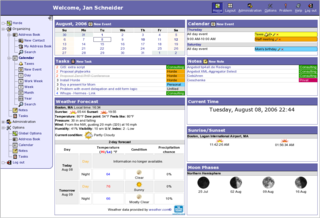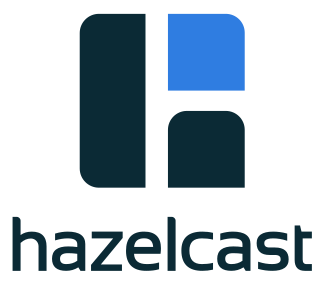An application server is a server that hosts applications.

A web application is application software that runs on a web server, unlike computer-based software programs that are run locally on the operating system (OS) of the device. Web applications are accessed by the user through a web browser with an active network connection. These applications are programmed using a client–server modeled structure—the user ("client") is provided services through an off-site server that is hosted by a third-party. Examples of commonly-used web applications include: web-mail, online retail sales, online banking, and online auctions.

WebObjects is a Java web application server and a server-based web application framework originally developed by NeXT Software, Inc. As of 2009 the software has been independently maintained by a volunteer community.
The Connected Device Configuration (CDC) is a specification of a framework for Java ME applications describing the basic set of libraries and virtual-machine features that must be present in an implementation. The CDC is combined with one or more profiles to give developers a platform for building applications on embedded devices ranging from pagers up to set-top boxes. The CDC was developed under the Java Community Process as JSR 36 and JSR 218.

Apache Tapestry is an open-source component-oriented Java web application framework conceptually similar to JavaServer Faces and Apache Wicket. Tapestry was created by Howard Lewis Ship, and was adopted by the Apache Software Foundation as a top-level project in 2006.
.NET Remoting is a Microsoft application programming interface (API) for interprocess communication released in 2002 with the 1.0 version of .NET Framework. It is one in a series of Microsoft technologies that began in 1990 with the first version of Object Linking and Embedding (OLE) for 16-bit Windows. Intermediate steps in the development of these technologies were Component Object Model (COM) released in 1993 and updated in 1995 as COM-95, Distributed Component Object Model (DCOM), released in 1997, and COM+ with its Microsoft Transaction Server (MTS), released in 2000. It is now superseded by Windows Communication Foundation (WCF), which is part of the .NET Framework 3.0.
WURFL is a set of proprietary application programming interfaces (APIs) and an XML configuration file which contains information about device capabilities and features for a variety of mobile devices, focused on mobile device detection. Until version 2.2, WURFL was released under an "open source / public domain" license. Prior to version 2.2, device information was contributed by developers around the world and the WURFL was updated frequently, reflecting new wireless devices coming on the market. In June 2011, the founder of the WURFL project, Luca Passani, and Steve Kamerman, the author of Tera-WURFL, a popular PHP WURFL API, formed ScientiaMobile, Inc to provide commercial mobile device detection support and services using WURFL. As of August 30, 2011, the ScientiaMobile WURFL APIs are licensed under a dual-license model, using the AGPL license for non-commercial use and a proprietary commercial license. The current version of the WURFL database itself is no longer open source.
jQuery is a JavaScript library designed to simplify HTML DOM tree traversal and manipulation, as well as event handling, CSS animation, and Ajax. It is free, open-source software using the permissive MIT License. As of May 2019, jQuery is used by 73% of the 10 million most popular websites. Web analysis indicates that it is the most widely deployed JavaScript library by a large margin, having at least 3 to 4 times more usage than any other JavaScript library.

Solr is an open-source enterprise-search platform, written in Java. Its major features include full-text search, hit highlighting, faceted search, real-time indexing, dynamic clustering, database integration, NoSQL features and rich document handling. Providing distributed search and index replication, Solr is designed for scalability and fault tolerance. Solr is widely used for enterprise search and analytics use cases and has an active development community and regular releases.
Google App Engine is a cloud computing platform as a service for developing and hosting web applications in Google-managed data centers. Applications are sandboxed and run across multiple servers. App Engine offers automatic scaling for web applications—as the number of requests increases for an application, App Engine automatically allocates more resources for the web application to handle the additional demand.

Rack is a modular interface between web servers and web applications developed in the Ruby programming language. With Rack, application programming interfaces (APIs) for web frameworks and middleware are wrapped into a single method call handling HTTP requests and responses.
In computing, Oracle Coherence is a Java-based distributed cache and in-memory data grid, intended for systems that require high availability, high scalability and low latency, particularly in cases that traditional relational database management systems provide insufficient throughput, or insufficient performance.

ColdBox is a free, open-source, conventions-based, modular web application framework intended for building enterprise applications with ColdFusion (CFML) using a Hierarchical MVC approach.

In computing, Hazelcast IMDG is an open source in-memory data grid based on Java. It is also the name of the company developing the product. The Hazelcast company is funded by venture capital and headquartered in San Mateo.
Elliptics is a distributed key-value data storage with open source code. By default it is a classic distributed hash table (DHT) with multiple replicas put in different groups. Elliptics was created to meet requirements of multi-datacenter and physically distributed storage locations when storing huge amount of medium and large files.

Apache Spark is an open-source unified analytics engine for large-scale data processing. Spark provides an interface for programming entire clusters with implicit data parallelism and fault tolerance. Originally developed at the University of California, Berkeley's AMPLab, the Spark codebase was later donated to the Apache Software Foundation, which has maintained it since.
Crosswalk Project is an open-source web app runtime built with the latest releases of Chromium and Blink from Google. These are also used in Google Chrome. The project's focus is to provide the most up-to-date and innovative capabilities to web apps including experimental APIs and extensibility. A web app that bundles the Crosswalk Project runtime can install and run on different Android versions with consistent behavior and feature parity.







